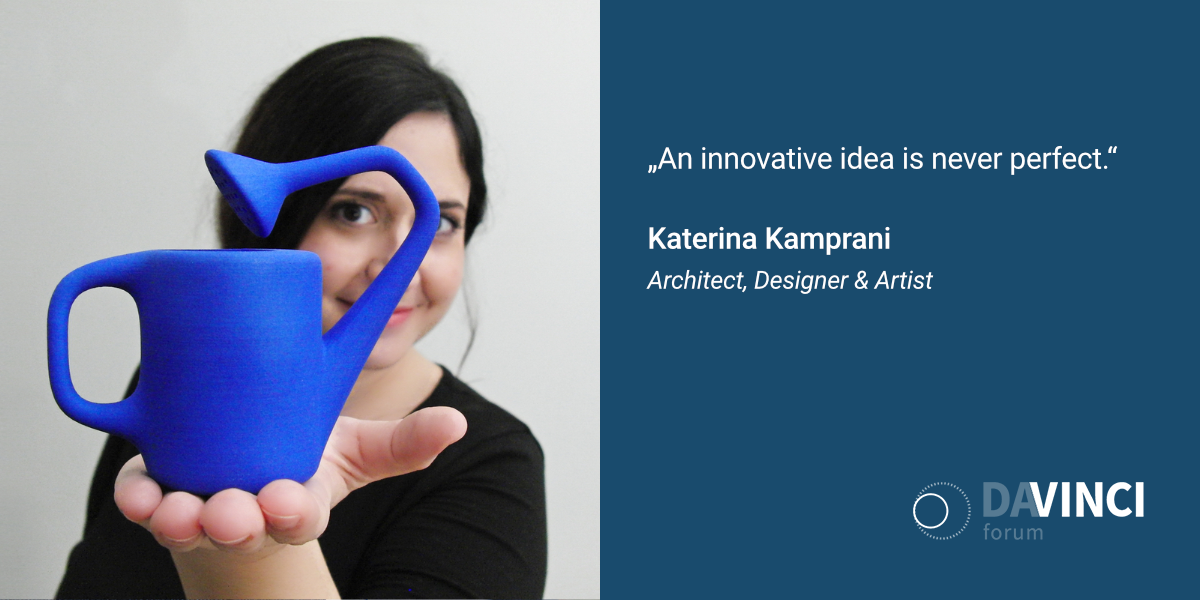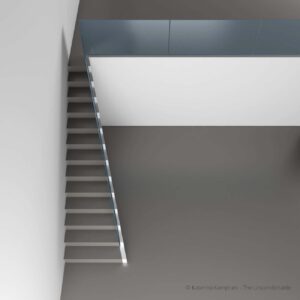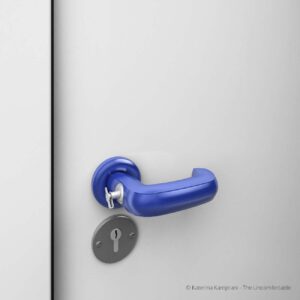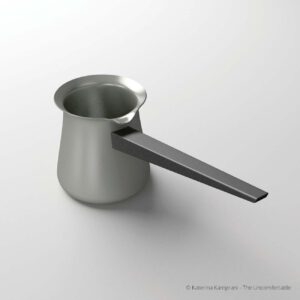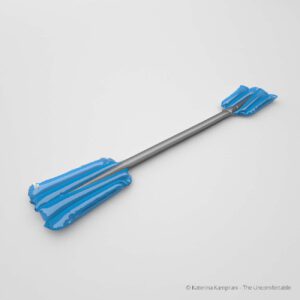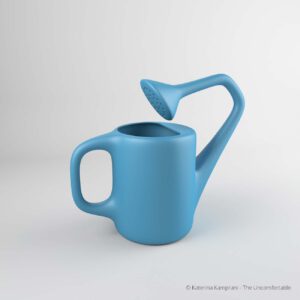Juli 2020 | Interview
Katerina Kamprani: Embracing the Uncomfortable
Katerina, how are you? How do you spend your time in the current Corona crisis?
I am good, thanks! Greece has been very good in responding to the crisis early. The 42 days I spent in lockdown were actually a very welcome break from my fast-paced lifestyle. Before the pandemic, I worked eight hours a day in an architectural office. I was spending my free time managing „The Uncomfortable“ project, preparing for two exhibitions in France and Germany. All commercial architecture projects were paused or cancelled and the art exhibitions were postponed. Although this created a fear for my future financially, I felt that it was the right thing to do. Protecting my health and the health of all people that are in higher risk is a priority. During the quarantine my creativity was very low. I focused more on connecting with people and helping my family, but I managed to be somehow productive and learned a new 3D software.
Now, my main goal is to try and focus on being creative and get distracted from everything that is going on in the world. In a certain way, I feel this is a new start for me artistically, since The Uncomfortable project started in a similar situation, after the economic crisis hit Greece very hard.
I am using all my skills to design what I think should not be done in real life projects. Share on X
You describe yourself as an artist, who designs “uncomfortable objects”. What does that mean?
It took me a long time to call myself an artist. Since I was very young I have been artistic, but growing up and especially during my studies as an architect I had an identity crisis. I like problem-solving, practical thinking but I also enjoy absurdity and surrealism. I felt that architecture was a huge responsibility to take on. Frankly, I was disappointed by architects that sacrifice practicality for aesthetics. I really enjoyed smart design objects and solutions I saw online. Then, I decided to take another path by intensifying my studies in design, just to realize that design was a huge responsibility too and that some designers sacrifice usability for “smart solutions” that are not well thought out. So now, I am using all my skills to design what I think should not be done in real life projects.
Click to enlarge
What is the intention behind your objects?
I want the viewer to be confused for a brief second. I choose to use everyday objects that everybody knows, for example how they look like and how they are used. Then I try to keep that object as intact as I can, but make it hard to use. I want them to still being usable in a certain way, giving them a friendly, naïve quality. I also make the images look like real product photography pictures so they are more convincing and cause more of a surprise when our brain finds out what is wrong with them.
How do you get the ideas for your objects?
For most objects I followed a methodology, which involves analyzing the object and how users interact with it. Then I choose to sabotage only one of these steps of interaction. But as the project progressed and I stopped doing that methodically. Now, sometimes ideas pop up in my head, usually because I saw or heard something that made me think differently.
And other times I get these great ideas, only to realize that it was something I saw on the internet years ago. When that happens, I have to be very careful of unintentional plagiarism.
Click to enlarge
You once said that your personal relationship with innovation is “a bit weird”. What do you mean by that?
I am quite skeptical when it comes to innovation. An innovative idea is never perfect and the only way to evolve is through trial and error. But many times, I just feel that innovative products are just trying to change something that has already been established through history. Especially when it comes to everyday objects, they are just not convincing enough. It is a paradox, because I feel that I can adjust into new ways of thinking or doing things, but I need a strong reason to do it.
I do not think that always going forward is the best. If something is not progressing well, we can always rethink, go backwards to something that worked better and start evolving another path.
On the other hand, I am very eager to try new software and tools for design. In that area, I have no problem to go through the trial and error process.
How do “comfortability” and innovation link together?
Innovation is the starting point. Comfortability is the driving force and the ultimate goal. And the cycle starts again.
How important is humor when it comes to lateral thinking?
Humor is a result of thinking outside the box. Having fun or amusement might not be a main goal for everybody. That, however, does not mean that some people’s brains are not able to think outside the box. However, I feel that a good comedian must be able to think differently since comedy is based on surprise.
I feel like it’s time again, that I should stop making plans for the future and start being creative. Share on X
What role does failure play for you in the creative process?
It has surely been a driving force for me! I am a person that does not like to take risks. My goal is always to be methodical and smart to minimize any chance of failure. When things go wrong, I take it to heart. Ten years ago, I felt that all my plans where failing either because I did something wrong, or because of the circumstances I could not control (like the economic crisis). It was very scary.
When I decided to stop the struggle and to relax my mind, I managed to occupy my brain with something that made me feel good. That is how The Uncomfortable project was born.
What are your plans for the future?
I feel like it’s time again, that I should stop making plans for the future and start being creative. I never had plans for The Uncomfortable anyway, it grew and is sustaining itself as a project very organically. All I do is making sure that it has a presence on social media platforms and ask for credit when it is used. It is mind-blowing that most of the pictures of my objects were made in 2012 and 2013 but are still relevant today.
Thank you very much, Katerina!
More about Katerina Kamprani:
Katerina Kamprani studied architecture at the National Technical University of Athens from where she received her diploma in 2006. In 2008 she started a postgraduate program in Design of Products and Interactive Systems at the University of the Aegean in an attempt to redefine her career. Her studies in industrial design were never completed and one year later she started her personal project, The Uncomfortable. Balancing humor, art and design, Katerina analyzes and redesigns everyday objects in order to make them inconvenient.
